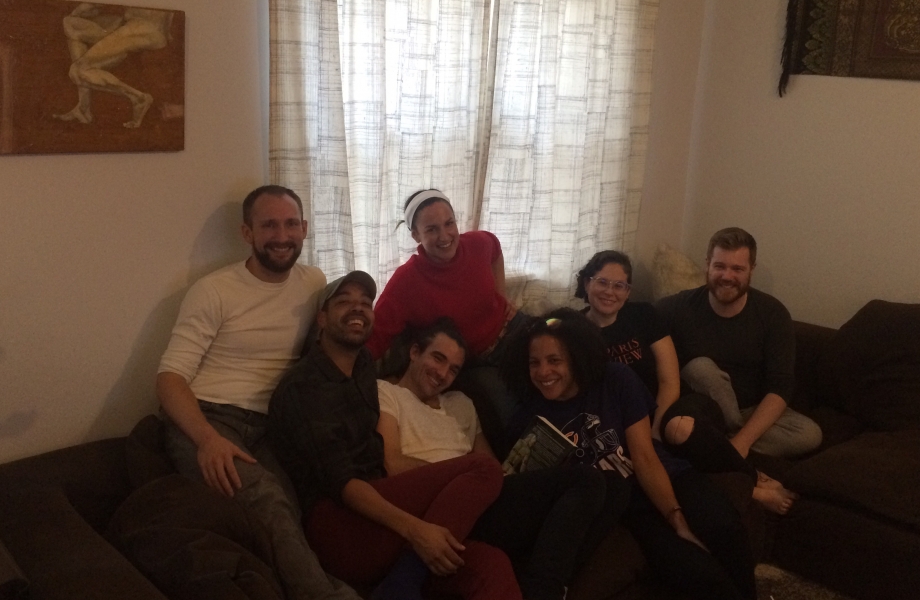Mystery Sci-Fi Theater
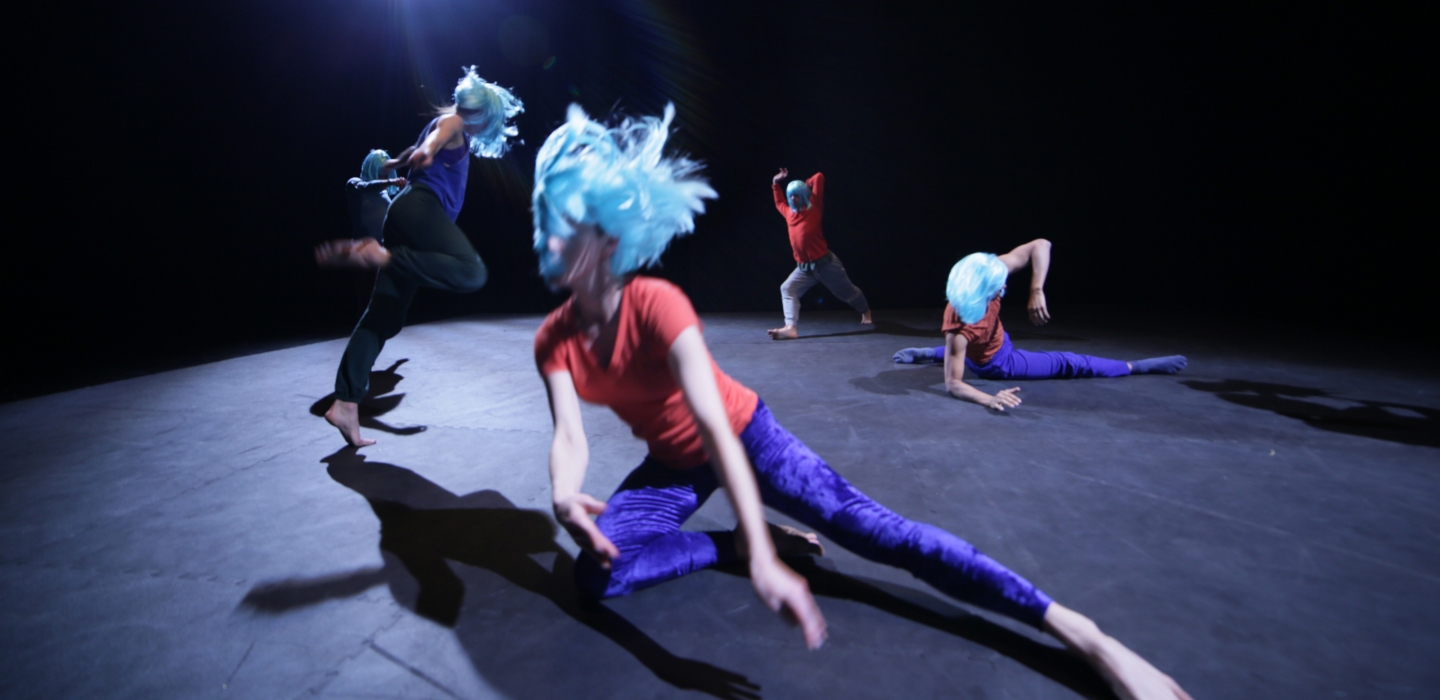
My experience with science fiction—reading it, watching it—is akin, I think, to many people’s experience with contemporary dance. I’m a novice, for whom even the genre’s most widely-known references mean little. So when Rashaun Mitchell and Silas Riener invited me to a meeting of their long-running sci-fi book club, where they would screen part of their recent multimedia opus, Tesseract, I welcomed the chance to view their work through the eyes of the sci-fi literate.
Tesseract unfolds in two parts; we watched the first, a 40-minute 3D film directed by Charles Atlas and choreographed by Mitchell and Riener. (The second half, a live performance, features video projections manipulated by Atlas in real time.) The three artists share a connection to Merce Cunningham: Atlas collaborated with Cunningham on many now-iconic dance films, beginning in the 1970s; Riener and Mitchell danced with Cunningham’s company during the final decade of his life.
Like sci-fi book club members Ted, Faye, Adrienne, Allison, and Conor, I had seen Tesseract at the Brooklyn Academy of Music’s Harvey Theater in December 2017. On a Sunday afternoon nearly a year later, we gathered in Ted and Faye’s Brooklyn apartment to revisit the film with commentary from the choreographers (and with bagels). The following is excerpted from a vociferous conversation full of observations, revelations, interruptions, questions, and arguments among friends.
[Title sequence rolls. A white tesseract, the four-dimensional analog of a cube, hovers in black outer space.]
Rashaun: I know this looks like nothing, but Charlie [Atlas] apparently worked on this cube rotating and changing for hours and hours and hours.
Allison: This is amazing, actually.
Ted: I remember loving this!
Rashaun: I think he’s more proud of that than anything else.
Silas: He had never done a title sequence before. He was so excited. That’s what makes it a real movie.
Allison: It helps you understand where you are.
Adrienne: Isn’t there a movie that does something similar to this?
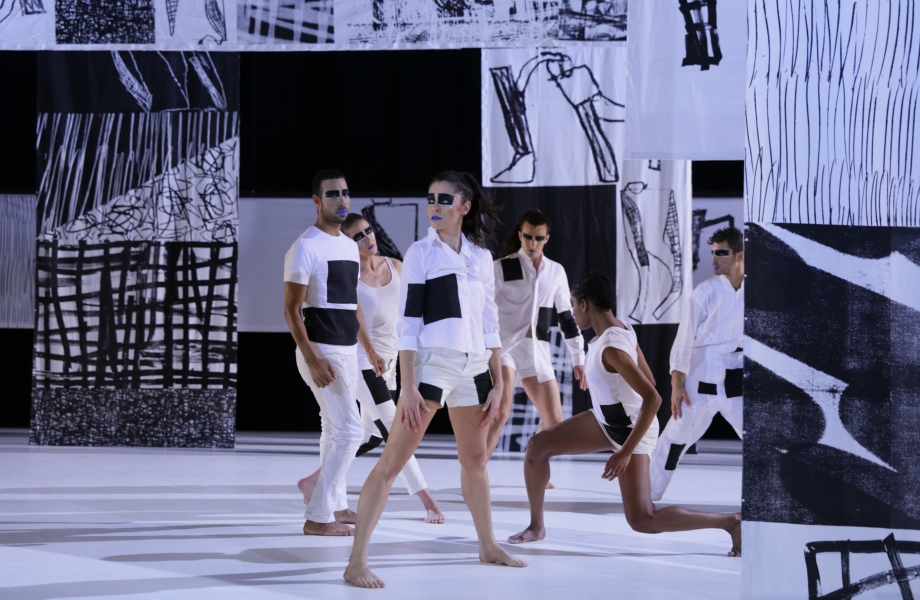
[Debate over whether it resembles The Matrix or A Wrinkle in Time or something else. First scene has begun. Dancers in black-and-white costumes, blue lipstick. Scenery that looks like the blown-up pages of an illustrator’s notebook.]
Adrienne: It must be so different dancing for film versus performance.
Silas: You basically have a pizza slice where the camera will capture you, so it’s really narrow in the foreground and more open in the background.
Conor: I want to know about costumes and makeup.
Silas: The whole proposal was that there would be these different environments, and they would be exploring time travel or dimensional travel, but through dance. Charlie is from a really different time. He’s 70. Actually, I don’t know how old he is. But I think crazy makeup and wigs and things that make people look really different and that play into space opera movies—I think those were appealing to him.
[My favorite Atlas/Cunningham film: The Coast Zone. Peach, blue, and purple leotards. Music that reminds me of insects. A wood-paneled room that might be a basement. There was a long excerpt on YouTube, but I think the Cunningham Trust took it down.]
Ted: I forgot how you played with the framing.
Allison: I forgot how intimate it was. Such an intimate relationship with a dancer that you don’t usually get. That first close-up on Melissa [Toogood]—it puts me into this mindset of waking up into her consciousness.
Ted: It’s comic book-like.
Adrienne: It is comic book-like.
Allison: How do you choreograph on different dancers?
Silas: You try to figure out who they are and what they’re interested in. Melissa, because she has kind of a calculator brain, wants certain rhythmic tasks combined with certain physical tasks. Cori [Kresge] is a little more sensitive and ethereal and otherworldly. She wants more psychological or interior-world tasks.
Conor: You guys should choreograph something for us.
[I would watch that.]
Silas: Is this when my back was in spasm and I couldn’t stand up?
Rashaun: I can’t remember—there were so many of those times.
Allison: This part is very mitochondrial.
Siobhan: Mitochondrial. I’m going to use that. I’ll credit you.
Silas: We’re the cilia now.
Conor: It could be a mating ritual, the one where three become one. Like in The Gods Themselves. Oh—I love this part!
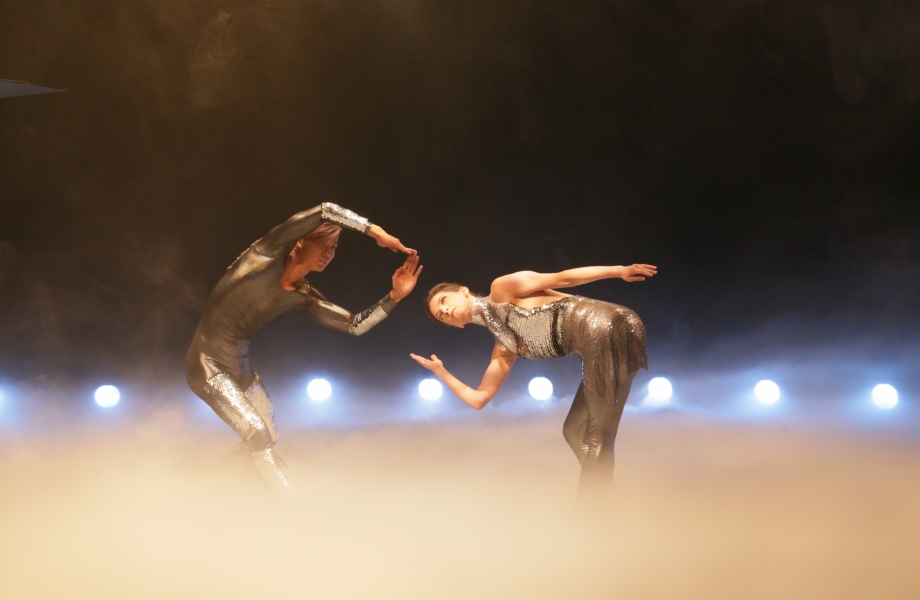
[Scene change. Dancers in darkness, thrashing on the floor, or some surface. Then quieter, a foggy room. Moon landing? Cori Kresge and Hiroki Ichinose in iridescent body suits.]
Allison: How do you guys choreograph together? How does that work?
Silas: Rashaun actually choreographed this part on his own for the show Light Years. It was two independent solos where they never look at each other because they’re in different dimensions.
Rashaun: They never touch.
Siobhan: They look kind of not real. Is that because we’re watching a 3D film in 2D?
Rashaun: I think it’s the lighting. The lighting places them somewhere else.
Conor: What do you mean by “not real”? What is real?
[A question I wasn’t expecting but appreciate.]
Siobhan: They look like cartoons or something.
Conor: Like animated?
Siobhan: Yeah, the quality of their skin. How smooth everything is.
Allison: If they’re in these parallel dimensions, why did her neck go back when he cut through with his hand?
[Another question I would not think to ask. Watching so much dance, you learn to accept ambiguity, to not seek resolution—or I have, at least. Maybe to a fault? I remember a conversation I had with a theater critic friend, about how dance writers are more comfortable with having no idea what’s going on, or should be.]
Rashaun: It’s that thing of being able to sense something that’s not there—having a psychic connection to a different dimension.
Silas: I always felt like they were inhabiting the same time-space but different dimensions. Somehow we could see them both, but they weren’t experiencing each other. They would never touch because they would just go right through each other.
Allison: Well that’s my question—why did she dip under his arm?
Rashaun: And my answer is that the questions are more interesting than the answers.
Silas: That’s always your answer.
[Scene change. A desert. Some kind of space station in the distance. Dancers in orange leotards with geometric protrusions.]
Ted: This one was too much for me.
Allison: It’s hyper-real.
Adrienne: I am getting a little O.G. Star Trek vibe.
Silas: They’re on the Holodeck.
Adrienne: No! They’ve landed on a foreign planet and Kirk’s trying to find a chick tonight!
[Everyone laughs. Scene change. Back to the thrashing dark room. Things turning upside down.]
Allison: This is like some incantation.
Adrienne: Yeah, it feels like some dark ritual.
Silas: Any time you’re in a circle doing the same thing, it’s a dark ritual.
Faye: With everyone having that green hair, it makes them seem like a different species. Like a family or cult.
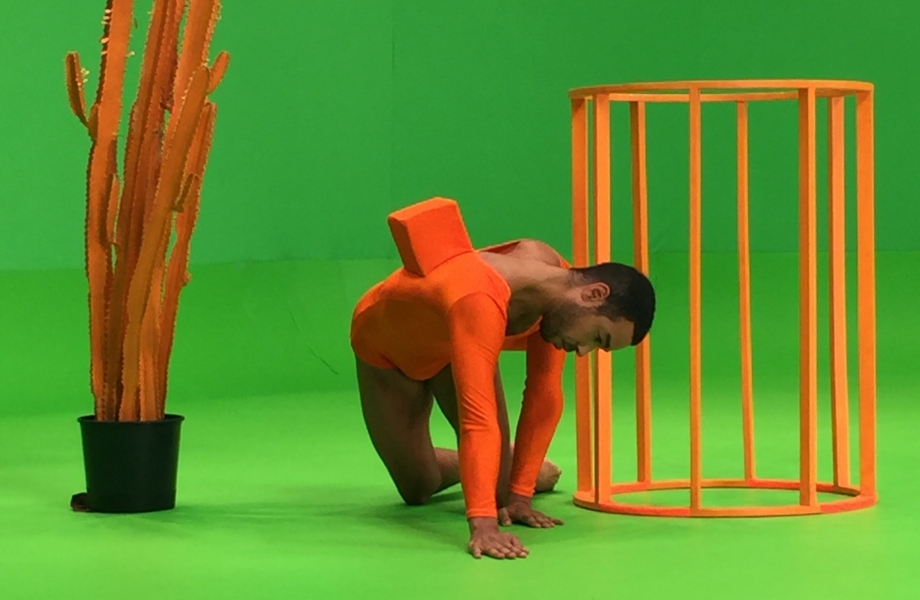
[Back to the desert.]
Silas: These were my favorite costumes.
Siobhan: What were you thinking with the shapes?
Silas: We wanted, like, cancerous outgrowths that became geometry.
Rashaun: I wanted this relationship between the fleshy, messy body and these geometric shapes. Also, while making this, we realized that the things that work best on-screen are the things closer to our past with Cunningham.
Silas: Things that register as shape and form.
Rashaun: Shapes and forms really read on-screen because energy gets flattened.
Allison: What is happening here?
Rashaun: We’re incongruous with these objects. We’re in a state of transformation.
Silas: We’re just jigglin’!
[Everyone laughs.]
Faye: Because they’re on this other planet, and with all the orange, it makes me feel like they all have radiation poisoning and they’ve developed these tumors.
Conor: I thought of this part as more of a nourishing process, like sleep.
Silas: There’s a very embedded reference to all of these dance projects from the early 20th century, like the Triadic Ballet and things where people embodied geometry in more pedantic ways. We were playing with that a little bit.
Rashaun: There’s also this conversation about otherness and belonging or not belonging. The cactus wants to be a shape but it’s not. But the cactus has a speed date with Cori.
[The cactus, we learn, was spray-painted orange and did not survive. Scene change. Rashaun and Silas look directly into the camera, speaking an unintelligible language.]
Rashaun: We’re newscasters of complete misinformation.
[Scene change. Dancers in puffy jumpsuits. Highlight of the film, in my opinion.]
Ted: Were these costumes comfy? They look comfy.
Adrienne: Who wouldn’t want to wear those around?
Siobhan: Is this the part that’s playing in reverse?
Rashaun: Yes.
[When I first saw it, I had no idea the choreography was playing in reverse. I think this says something about the counter-intuitiveness, to begin with, of Cunningham-inspired movement. Convoluted is its natural state; to rewind it is not so disruptive.]
Rashaun: And P.S., the choreography works well in real time, too, just regular, going forward. This scene is probably the most intricate in terms of steps. Charlie was worried about reversing the material. He was like, Is this O.K.? And we were like, Yeah, we made this so you could manipulate it. We can make a live dance any day. Do whatever you want to it.
Silas: We wanted him to mix it up even more. The whole film ended up being much more episodic than we expected, one world followed by the next world.
Rashaun: We thought it would be more rollercoaster-y.
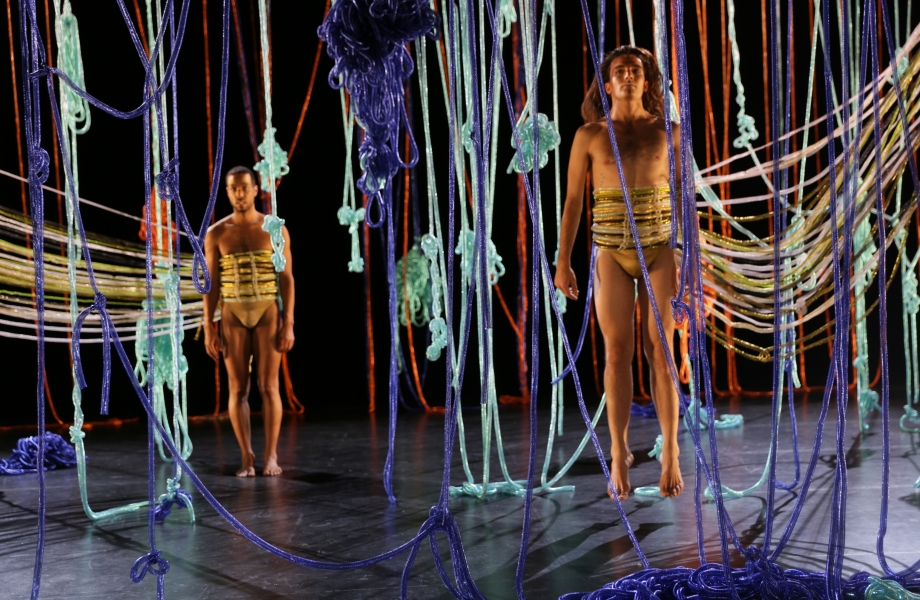
[Scene change. Rashaun and Silas—and the room around them—decked out in entrails. At one point Rashaun appears to give birth to Silas.]
Faye: Oh my God—this is my favorite scene. I love the ropes hanging. You look like centaurs with horse tails.
Silas: It’s like a corset with a tail. We used this material, tubular crinoline, that we had from a previous piece. We strung it up into the rafters and made these weird technological jungle shapes.
Adrienne: But at the same time it also feels like intestines.
Rashaun: Yeah, there’s something gross about it.
Allison: This is the heart of the matter.
Rashaun: This is the butt of the matter.
Allison: This is the straight-up draggy dragness of the reality of the car wash.
Adrienne: It is reminiscent of a car wash.
Silas: A gay space carwash?
[Lull in conversation.]
Silas: Technological, animal, intestinal.
Adrienne: There’s also a birdlike aspect. Plumage.
Faye: Is it different to dance to silence versus music?
Silas: Yeah.
Rashaun: Not really.
[Everyone laughs. The conversation is going so strong, in so many directions, that it takes a minute for people to notice the movie has ended.]
